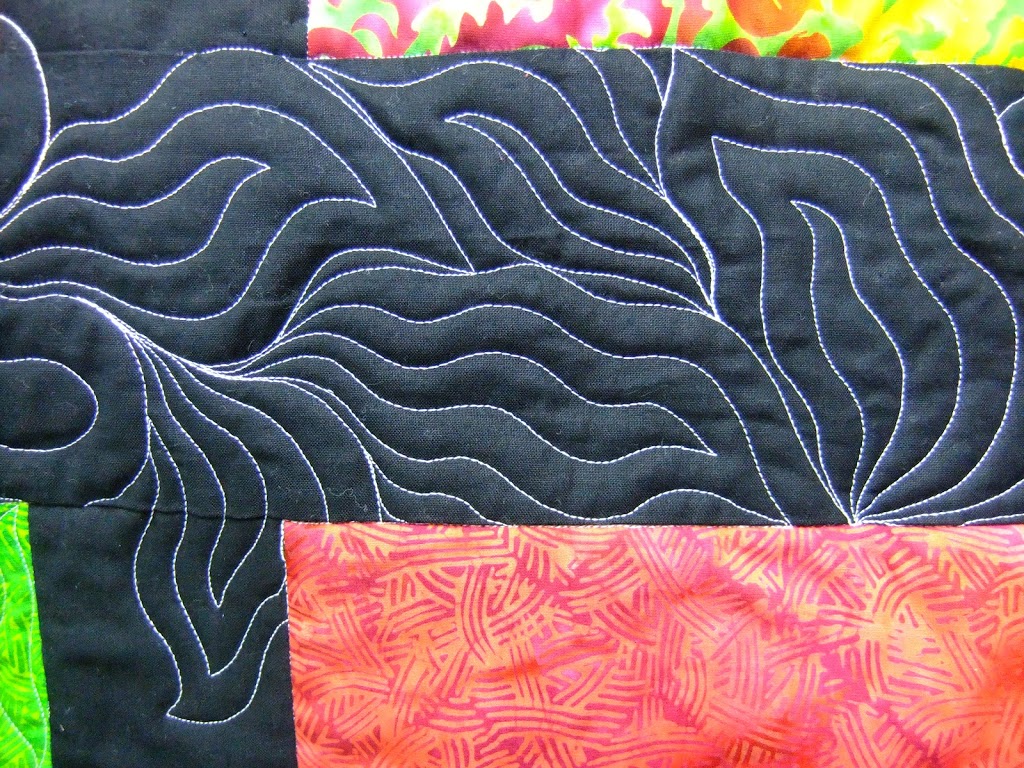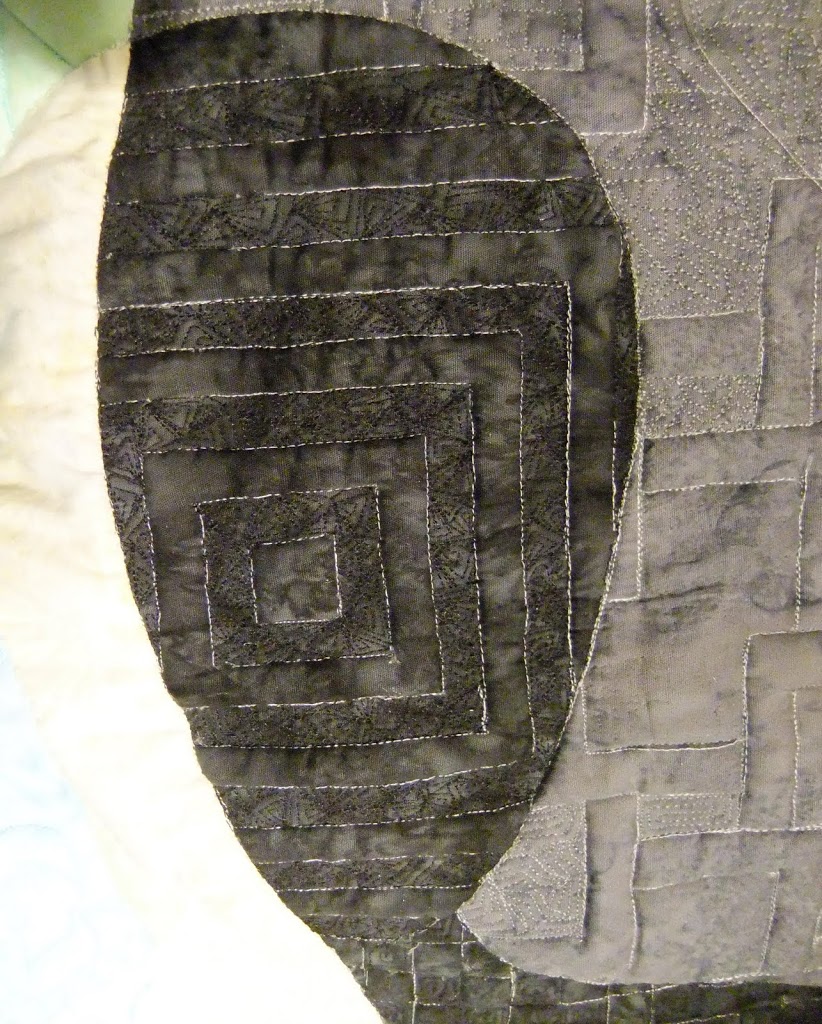UFO Followup #5
In fact, it seems I only got the tip of the iceberg when it comes to bad reactions. As Pat at Color Me Quilty shared this week, it can be far worse to see a quilt you’ve given be nearly destroyed by improper handling:
 |
| Photo from Pat’s blog: Color Me Quilty |
Pat is seriously needing some help to know whether to fix and repair this quilt or simply start over from scratch.
Personally, I would chuck this quilt. There’s really no saving something that’s shredded this badly. It would be one thing if it was just on the front, or just in one spot where the area could be covered with an applique, but there’s shredded fabric on all sides.
Kind of think of it like a doctor looking at a burn victim. If a quilt is shredded on both sides and the binding, it’s like a person that’s been burned over 90% of their body. Yes, it’s possible to fix it, but it will be a LOT of work and will probably never look the same.
I also wouldn’t replace this quilt right away. No, I’m not advising you to punish the child, but the fact is this quilt wasn’t taken care of properly. Logically if the kid has a bit more time to want a new, not damaged quilt, then he might appreciate it more this time around, and chances are his mother will take better care of it.
The fact is, we can’t control what happens to quilts once they leave our keeping. They will be used and abused because that’s what quilts are for.
And this kind of links back to free motion quilting. I quilt my bed quilts on a 1/2″ scale. To some quilters, this seems dense, though it is still very soft and cuddly.
Why do I stick with this scale? Because it’s secure! If a quilt is meant to be used and enjoyed, I want it to be able to take the maximum amount of wear with the least amount of tear.
More stitching simply means more security and stability in the finished quilt. Why do you think hand quilters still rate themselves by the number of stitches per inch? More stitching is BETTER!
But of course not too much stitching, or you end up with a cardboard blanket and that won’t be soft or cuddly for anyone to play with. There is a balance here, you just have to find it.
Here’s a great quote from B from the Mariner’s Compass Quilting Project:
So moral of that story is you don’t have to fix every mistake immediately, you don’t have to worry about every wobbly stitch and you certainly don’t have to let it put you off moving forwards. The more forwards you move, the more confident you get and the more forgiving you can be about those early mistakes and actually enjoy seeing them as proof of the learning process and your accomplishments.
If you stitch a quilt too densely, who cares! It’s a learning experience! Just get a quilt on your machine and TRY IT. So many quilters question, question, question me about scale, polyester thread, batting, etc, asking asking asking questions to make it all make 100% perfect sense in their heads before getting started.
I understand this and am patient with it, but the fact is having all the answers isn’t the answer! Sometimes you just have to get on your machine and do some stitching in order to see for yourself what works, what scale looks nice, what batting works the best, etc.
Speaking of jumping in and trying it, Laura Stermer of L2D2 Designs is playing with trapunto on her eagle quilt. She shared the following question:
Should I try to trapunto the blue body of the eagle? I’m worried that the weight of the applique will negate any extra batting I add.
This is a common fear that multiple layers of cotton fabric will stop the puff from really puffing on a trapuntoed quilt.
So here’s the deal: yes, you will get a very nice puffy trapunto effect wherever you want to add it.
It doesn’t matter if you have applique, lots of piecing, or multiple layers of fabric, an extra layer of batting will definitely show. You can see this here in Shadow Self, I trapuntoed huge sections of this quilt through multiple layers of applique and it showed up wonderfully.
But there is one caveat here: you have to quilt the background DENSELY.
So if Laura adds trapunto to her eagle, it will be puffier, but the puff will only show up nicely if the background around it, the wings of the eagle for example, are quilted very densely.
Think of it as creating hills and valleys in your quilt. In order for the hills to be nice lofty hills, you need to create some deep, flat valleys.
But also keep in mind that trapunto is a finicky technique that needs some practice and experimentation before trying on a really big, really important quilt. Why? Because you need to know exactly what combination of materials will work together and stay very FLAT with no shrinkage after soaking.
And this is unfortunately something Danielle Hudson from Fresh off the Spool found out this week. Using unfamiliar materials, her beautiful wallhanging shrunk dramatically and is distorting the quilting design.
Make sure to check her post and read the comments where I’ve posted tips on how to hopefully stretch out the quilt and lock it back into the correct shape.
Always remember that mistakes happen. This is a learning craft and with every quilt you will learn something new. Some lessons you will have to learn multiple times, some lessons you only have to learn once. Some lessons are easy to swallow, some lessons will hurt badly.
This is the nature of our craft! If we wanted an easier road we’d all be scrapbooking! LOL!
So go make some mistakes, but don’t beat yourself up for them. Learn to love the process of learning, mistakes and disasters, triumphs and successes all combined.
Let’s go quilt,
Leah



Love this post!
A lady asked me this weekend "how long did it take you to learn to free-motion quilt?"
I wanted to say "I haven't stopped learning yet!" but instead I said "you need to just give it a try and practice practice practice. It gets easier the more you DO it."
And B is right – I look back at my mistakes and mis-steps and am pleased I've come as far as I have!
Great post!
Oh, God, Leah, I'm glad you're not a doctor. "Look, people, this patient is 90% gone. So . . . I'm calling it, okay?" 😀
P.S. For the record, I said the quilt was beyond repair too.
Thank you Leah! It kind of feels good that everyone says to chuck it and start over. The thought of trying to fix it would make me really sad to work on it. But a new quilt is a new quilt. As a matter of fact, this quilt was quilted by someone with a long-arm, before I realized that I could do it myself. I live the idea of giving a new quilt, that I quilted, to my grandson at some later date. You ROCK Leah, thank you for sharing so much of yourself.
Jenny – LOL! You realize my dad really wanted me to be a doctor? I actually went through 2 years of a biology degree in that direction before I realized…no…I really can't do this. I would end up saying something exactly like that!
Leah
LOL You guys just made my day! I am afraid Leah, that I am going to mnemonically refer to you as Dr. Leah now.. unless of course I am 90% gone 😀
I think a child's quilt is to be loved, hugged, and well used but this one is damaged beyond its original use. Maybe with the remnants you could make a teddy bear or favorite animal that survived the match box car incident. It's a good story line.